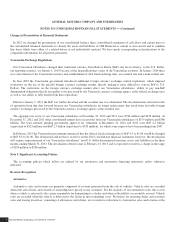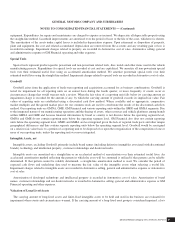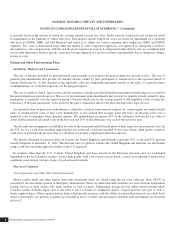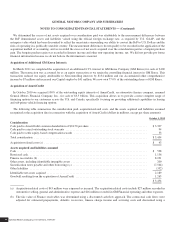General Motors 2012 Annual Report Download - page 86
Download and view the complete annual report
Please find page 86 of the 2012 General Motors annual report below. You can navigate through the pages in the report by either clicking on the pages listed below, or by using the keyword search tool below to find specific information within the annual report.
GENERAL MOTORS COMPANY AND SUBSIDIARIES
NOTES TO CONSOLIDATED FINANCIAL STATEMENTS — (Continued)
Common and Preferred Stock
Common and preferred stock for which market prices are readily available at the measurement date, are valued at the last reported
sale price or official closing price on the primary market or exchange on which they are actively traded and are classified in Level 1.
Such equity securities for which the market is not considered to be active are valued via the use of observable inputs, which may
include, among others, the use of adjusted market prices last available, bids or last available sales prices and/or other observable
inputs and are classified in Level 2. Common and preferred stock classified in Level 3 are those privately issued securities or other
issues that are valued via the use of valuation models using significant unobservable inputs that generally consider among others, aged
(stale) pricing, earnings multiples, discounted cash flows and/or other qualitative and quantitative factors. We may consider other
security attributes such as liquidity and market activity in assessing the observability of inputs used by pricing services or dealers,
which may affect classification in the fair value hierarchy.
Government, Agency and Corporate Debt Securities
U.S. government and government agency obligations, foreign government and government agency obligations, municipal
securities, supranational obligations, corporate bonds, bank notes, and preferred securities are valued based on quotations received
from independent pricing services or from dealers who make markets in such securities. Debt securities which are priced via the use
of pricing services that utilize matrix pricing which considers readily observable inputs such as the yield or price of bonds of
comparable quality, coupon, maturity and type as well as dealer supplied prices, are classified in Level 2. Securities within this
category that are typically priced by dealers and pricing services via the use of proprietary pricing models which incorporate
significant unobservable inputs are classified in Level 3. These inputs primarily consist of yield and credit spread assumptions. We
may consider other security attributes such as liquidity, market activity, price level, credit ratings and geo-political risk in assessing
the observability of inputs used by pricing services or dealers, which may affect classification.
Agency and Non-Agency Mortgage and Other Asset-Backed Securities
U.S. and foreign government agency mortgage and asset-backed securities, non-agency collateralized mortgage obligations,
commercial mortgage securities, residential mortgage securities and other asset-backed securities are valued based on quotations
received from independent pricing services or from dealers who make markets in such securities. Securities which are priced via the
use of pricing services that utilize matrix pricing which considers readily observable inputs such as prepayment speed assumptions,
attributes of the collateral, yield or price of bonds of comparable quality, coupon, maturity and type as well as dealer supplied prices
are classified in Level 2. Securities within this category that are typically priced by dealers and pricing services via the use of
proprietary pricing models which incorporate significant unobservable inputs are classified in Level 3. These inputs primarily consist
of prepayment curves, discount rates, default assumptions and recovery rates. We may consider other security attributes such as
liquidity, market activity, price level and other factors in assessing the observability of inputs used by pricing services or dealers,
which may affect classification.
Investment Funds, Private Equity and Debt Investments and Real Estate Investments
Investments in exchange traded funds, real estate investment trusts and mutual funds, for which market quotations are generally
readily available, are valued at the last reported sale price, official closing price or publicly available NAV (or its equivalent) on the
primary market or exchange on which they are traded, and are classified in Level 1. Investments in private investment funds
(including hedge funds, private equity funds and real estate funds) are generally valued based on their respective NAV (or its
equivalent), as a practical expedient to estimate fair value due to the absence of readily available market prices. Investments in private
investment funds, which may be fully redeemed at NAV in the near-term are generally classified in Level 2. Investments in funds,
which may not be fully redeemed at NAV in the near-term, are generally classified in Level 3.
Direct investments in private equity, private debt and real estate securities, are generally valued in good faith via the use of the
market approach (earnings multiples from comparable companies) or the income approach (discounted cash flow techniques), and
General Motors Company 2012 ANNUAL REPORT 83
























